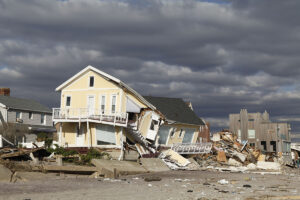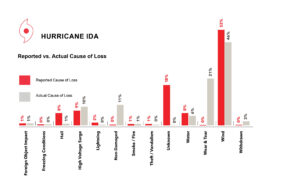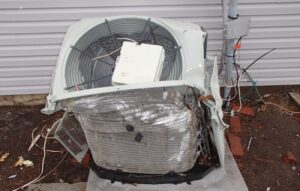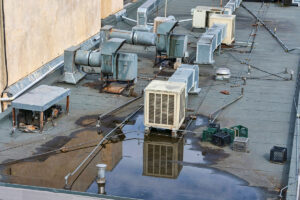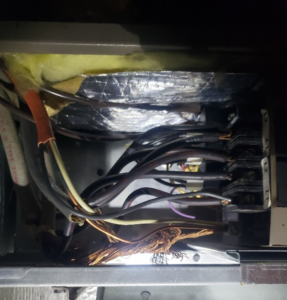Which HVAC Components Are at Risk for Hurricane Damage?
Hurricanes leave varying degrees of damage in their wake, such as this house destroyed by Superstorm Sandy.
HVACi was a trusted damage assessment expert that adjusters relied on to evaluate HVAC and Refrigeration equipment following Hurricane Ida. The Category 4 storm surpassed Superstorm Sandy and the three most destructive 2017 hurricanes to become the second costliest U.S. hurricane, according to recent Insurance Information Institute data. Adjusters can use the cause of loss determinations from those claims assessments to better understand which HVAC components are most at risk for hurricane damage and why.
The CCG IQ 2021 Annual Report shows what insureds reported as cause of loss versus what HVACi experts determined during HVAC assessments from Hurricane Ida claims.
Wind Impacts to Exterior Components
Hurricanes are ranked by their wind speeds through the Saffir-Simpson Hurricane Wind Scale, so it’s likely not a surprise that wind was both the most often reported and actual cause of loss for HVAC systems affected by Hurricane Ida.
External HVAC components in split systems and package units are most susceptible to wind-related losses.
Windblown debris could clog the condenser coils or cause major damages, such as this crushed condensing unit.
Windblown dust and debris can clog the condenser coil, which is essential in the heating and cooling processes for most HVAC systems. Traditional condenser coils have aluminum fins surrounding copper pipes filled with refrigerant. Obstructed fins can restrict air flow, though lower efficiency occurs when they are almost entirely blocked. Safely cleaning off dust and debris could eliminate the need for replacements.
Tree limbs, patio umbrellas, and other objects blown into a condensing unit could require settlements for more major repairs. Policyholders may need new condenser coils, or in more severe scenarios, a new condensing unit. Rarely is a full HVAC system replacement necessary.
Wind directly impacts condensing units in split systems and package units, too. Equipment may be tipped or knocked from concrete or plastic pads, elevated brackets, or rooftop installations. A full replacement may be necessary for package units blown from a roof to the ground. A new condensing unit, lineset, and additional components could return split systems with major damage to pre-loss condition.
An objective HVAC system expert should determine the scope of damage and accurate solutions before carriers settle for unnecessary equipment.
Rain, Floods, And Storm Surges
Hurricanes, also called tropical cyclones, are made up of thunderstorms that form over the ocean and move inland. Water-related losses come from the torrential rains, flooding, and storm surges that are common when hurricanes strike coastal areas.
HVAC system location impacts which equipment is most at risk for water-related damages. Components on the ground or in the crawlspace and basement are susceptible to flooding and storm surge, though flood-prone areas often have building elevation requirements to reduce losses. HVAC equipment in the attic or upper levels isn’t immune. Roof damage could cause rainwater to affect indoor equipment.
HVAC system location impacts what types of water losses it could sustain.
Where water contacts the HVAC system also affects scope of damage. Condensing unit components most at risk for water damage include electrical equipment, the compressor, and the fan motor. The force of floodwaters could shift a condensing unit. Saltwater also corrodes or deteriorates condenser coils, though this may be a sign of wear and tear.
Inside, air handler or furnace components susceptible to water damage include the control board, wires, capacitors, gas valve, blower, and other equipment. Sheet metal ductwork, flex ductwork, ductboard, and insulation sustain varying degrees of water damage, which could result in repairs or replacements.
Once water reaches electrical components, more major repairs may be necessary; however, water contact with lower sections may have minimal impacts. An HVAC expert can assess the water damage to determine the scope of loss and what repairs would return equipment to pre-loss condition. An assessment would also define the source of the water, as flooding, surface water, and groundwater may not be covered by all insurance policies.
Lightning and High Voltage Surge Impact Electrical Components
Direct lightning damage is rare for HVAC systems. When it occurs, direct lightning causes visible impacts such as arcing, burning, and electrical malfunctions. In contrast, high voltage surge was the second most common cause of loss for HVAC equipment assessed after Hurricane Ida.
High voltage surge damage is common after hurricanes for several reasons, including nearby lightning, loss of power, or other voltage fluctuations.
High voltage surges are the result of nearby lightning strikes, power outages, and other voltage fluctuations that affect the power grid, transformers, wires, and electrical components. Surge losses are confined to the electrical system and use wiring as their path. Malfunctions could occur to multiple components and may not be visible.
Non-Covered Perils Appear in Hurricane Claims
Hurricane perils, including wind, water, and high voltage surge, can cause minor to major damages, though it’s critical to note that these often don’t result in the need for full system replacements. Only 42% of HVAC equipment that HVACi experts evaluated after Hurricane Ida needed full replacement.
Equally as important, many hurricane claims have causes of loss that aren’t typically covered. Wear and tear accounted for 21% of the damages assessed after Hurricane Ida, and 11% of equipment was non-damaged at the time of assessment.
HVAC system experts can ensure claim settlement accuracy by determining cause of loss and scope of damage. HVACi has a network of thousands of professionals who evaluate HVAC and Refrigeration equipment nationwide. Adjusters receive comprehensive reports with verified cause of loss, repair and replacement recommendations, and settlement recommendations based on market value pricing – without slowing down the claims process.
Need help with a hurricane-related claim that involves HVAC systems? Submit a claim to HVACi for quick, comprehensive solutions.


